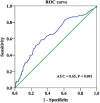The Value of Big Endothelin-1 in the Assessment of the Severity of Coronary Artery Calcification
- PMID: 29562761
- PMCID: PMC6714734
- DOI: 10.1177/1076029618764846
The Value of Big Endothelin-1 in the Assessment of the Severity of Coronary Artery Calcification
Abstract
Progression of coronary artery calcification (CAC) was significantly associated with all-cause mortality, and high coronary artery calcium score (CACS) portends a particularly high risk of cardiovascular events. But how often one should rescan is still an unanswered question. Preliminary screening by testing circulating biomarker may be an alternative before repeat computed tomography (CT) scan. The aim of this study was to investigate the value of big endothelin-1 (bigET-1), the precursor of endothelin-1 (ET-1), in predicting the severity of CAC. A total of 428 consecutively patients who performed coronary computed tomography angiography (CCTA) due to chest pain in Fuwai Hospital were included in the study. The clinical characteristics, CACS, and laboratory data were collected, and plasma bigET-1 was detected by enzyme-linked immunosorbent assay (ELISA). The bigET-1 was positively correlated with the CACS ( r = .232, P < .001), and the prevalence of CACS >400 increased significantly in the highest bigET-1 tertile than the lowest tertile. Multivariate analysis showed that bigET-1was the independent predictor of the presence of CACS >400 (odds ratio [OR] = 1.721, 95% confidence interval [CI], 1.002-2.956, P = .049). The receiver operating characteristic (ROC) curve analysis showed that the optimal cutoff value of bigET-1 for predicting CACS >400 was 0.38 pmol/L, with a sensitivity of 59% and specificity of 68% (area under curve [AUC] = 0.65, 95% CI, 0.58-0.72, P < .001). The present study demonstrated that the circulating bigET-1 was valuable in the assessment of the severity of CAC.
Keywords: atherosclerosis; big endothelin-1; coronary artery calcium score.
Conflict of interest statement
Figures





Similar articles
-
Association of Big Endothelin-1 with Coronary Artery Calcification.PLoS One. 2015 Nov 13;10(11):e0142458. doi: 10.1371/journal.pone.0142458. eCollection 2015. PLoS One. 2015. PMID: 26565974 Free PMC article.
-
Association between circulating big endothelin-1 and noncalcified or mixed coronary atherosclerotic plaques.Coron Artery Dis. 2019 Sep;30(6):461-466. doi: 10.1097/MCA.0000000000000752. Coron Artery Dis. 2019. PMID: 30994493 Free PMC article.
-
Coronary computed tomography angiography and calcium scoring in routine clinical practice for identification of patients who require revascularization.Arch Cardiovasc Dis. 2016 Jun-Jul;109(6-7):412-21. doi: 10.1016/j.acvd.2016.01.013. Epub 2016 May 20. Arch Cardiovasc Dis. 2016. PMID: 27215378
-
Triglyceride glucose index is an independent predictor for the progression of coronary artery calcification in the absence of heavy coronary artery calcification at baseline.Cardiovasc Diabetol. 2020 Mar 16;19(1):34. doi: 10.1186/s12933-020-01008-5. Cardiovasc Diabetol. 2020. PMID: 32178666 Free PMC article.
-
Computed Tomography for Coronary Artery Calcification Scoring: Mammogram for the Heart.Prog Cardiovasc Dis. 2016 Mar-Apr;58(5):529-36. doi: 10.1016/j.pcad.2016.01.007. Epub 2016 Feb 15. Prog Cardiovasc Dis. 2016. PMID: 26892393 Review.
Cited by
-
Uremic Toxins and Vascular Calcification-Missing the Forest for All the Trees.Toxins (Basel). 2020 Sep 29;12(10):624. doi: 10.3390/toxins12100624. Toxins (Basel). 2020. PMID: 33003628 Free PMC article. Review.
-
Endothelin-1 in Health and Disease.Int J Mol Sci. 2023 Jul 10;24(14):11295. doi: 10.3390/ijms241411295. Int J Mol Sci. 2023. PMID: 37511055 Free PMC article. Review.
-
Plasma Big Endothelin-1 Levels and Long-Term Outcomes in Patients With Atrial Fibrillation and Acute Coronary Syndrome or Undergoing Percutaneous Coronary Intervention.Front Cardiovasc Med. 2022 Mar 3;9:756082. doi: 10.3389/fcvm.2022.756082. eCollection 2022. Front Cardiovasc Med. 2022. PMID: 35310980 Free PMC article.
-
Association between Plasma Big Endothelin-1 Level and The Severity of Coronary Artery Disease in Patients with Non-ST Segment-Elevated Myocardial Infarction.Arq Bras Cardiol. 2023 Feb;120(2):e20220294. doi: 10.36660/abc.20220294. Arq Bras Cardiol. 2023. PMID: 36888778 Free PMC article. English, Portuguese.
References
-
- Sangiorgi G, Rumberger JA, Severson A, et al. Arterial calcification and not lumen stenosis is highly correlated with atherosclerotic plaque burden in humans: a histologic study of 723 coronary artery segments using nondecalcifying methodology. J Am Coll Cardiol. 1998;31(1):126–133. - PubMed
-
- Detrano R, Guerci AD, Carr JJ, et al. Coronary calcium as a predictor of coronary events in four racial or ethnic groups. N Engl J Med. 2008;358(13):1336–1345. - PubMed
-
- Paixao AR, Ayers CR, El Sabbagh A, et al. Coronary artery calcium improves risk classification in younger populations. JACC Cardiovasc Imaging. 2015;8(11):1285–1293. - PubMed
-
- Baber U, Mehran R, Sartori S, et al. Prevalence, impact, and predictive value of detecting subclinical coronary and carotid atherosclerosis in asymptomatic adults: the BioImage study. J Am Coll Cardiol. 2015;65(11):1065–1074. - PubMed
-
- Shaw LJ, Giambrone AE, Blaha MJ, et al. Long-term prognosis after coronary artery calcification testing in asymptomatic patients: a cohort study. Ann Intern Med. 2015;163(1):14–21. - PubMed
MeSH terms
Substances
LinkOut - more resources
Full Text Sources
Other Literature Sources
Medical

